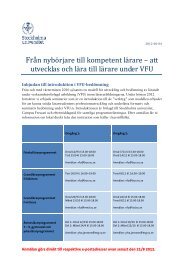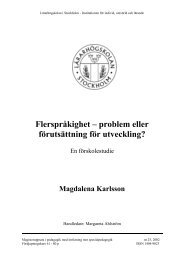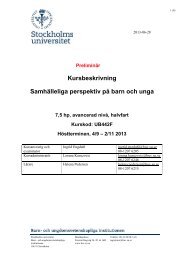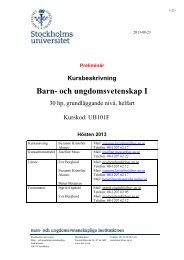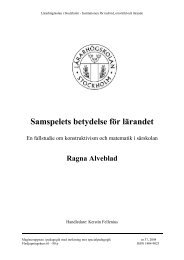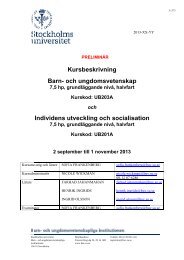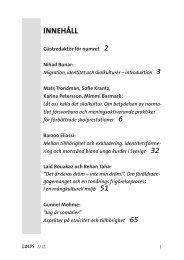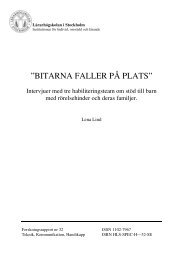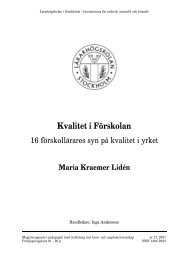Nr 51 - och ungdomsvetenskapliga institutionen, BUV - Stockholms ...
Nr 51 - och ungdomsvetenskapliga institutionen, BUV - Stockholms ...
Nr 51 - och ungdomsvetenskapliga institutionen, BUV - Stockholms ...
Create successful ePaper yourself
Turn your PDF publications into a flip-book with our unique Google optimized e-Paper software.
AbstractEngdahl, Karin (2005). The pre-school playground – the forgotten outdoor space? – Anempirical study of children’s play and interaction in two pre-school playgrounds. MAProgramme Child and Youth science, 61-80 credits. Stockholm Institute of Education.These days, children’s everyday experience of the outdoor environment largely stops withinthe bounds of their own playground. Ever increasing group size and a reduced staff/childratio has meant that long excursions outside the playground are no longer possible to thesame extent as they were previously. This study has therefore concentrated on the children’soutdoor environment and the time spent together on a daily basis, in two pre-schoolplaygrounds. The study also focuses on the social interaction between the children duringfree play in various outdoor settings. In the months of June and July the children’s dailyinteraction during outdoor play was observed in their respective playgrounds.The study has an ethnographic approach in so far as the children were observed in aneveryday context where the main aim was to illustrate how interaction takes place betweenchildren during free play and time spent together socially. An additional aim was to gather anumber of questions based on the children’s interaction. In the future, these questions couldform the basis of a more in-depth study, regarding the way children play and interact in thearena of the playground, and in other settings.Despite the inherent complexity of children’s play and social interaction, which can beexplained from various theoretical standpoints, in this study one can discern certaindifferences in the play and social interaction of the children in the two pre-schoolplaygrounds. In one the playgrounds children tend to have more conflicts and play in shorterbursts compared to the group of children observed in the other playground.Children’s play and social interaction are compound phenomena, something which findsexpression in the analysis and the discussion and the findings of this study. It is not possibleto suggest simple reasons for the differences in the number of conflicts shown in the study;on the other hand, follow up questions for further studies have been generated. There,different factors such as adult presence and its importance for play, and the importance of thesocial context in play and interaction in different socio-economic settings could be studiedthrough interdisciplinary conceptions and perspective.Key words: pre-school, (outdoor) play, interaction, sensitivity, interaction, communication,conflict.



